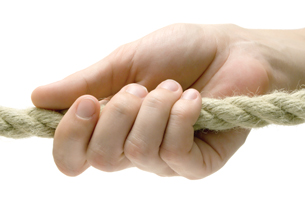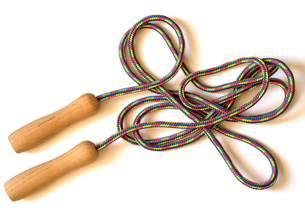Module 8—Mechanical Waves
 Reflect and Connect
Reflect and Connect

© Marc Dietrich/shutterstock
In your house or classroom, find a rope, a string, or even a long electrical extension cord. The rope should be more than 3 m long. Tie one end of the rope to a fixed position, such as a doorknob or railing. Hold the other end in your hand, and pull the rope tightly straight outwards from the fixed end. If you move the end in your hand up and down once, you will see the wave travel down the length of the rope until it reaches the fixed end, at which point it will be reflected. If you move your hand up and down continually at a constant frequency, you will start to observe interference as new waves make contact with reflected waves. The pattern of constructive and destructive interference may look completely random, but if you slowly increase the frequency at which your hand moves up and down, a standing wave pattern will appear. Once you see the standing wave pattern, you can maintain it as long as you keep the frequency constant.
By looking at the rope, you should be able to identify the nodes (spots that do not move) and the antinodes (spots that flip up and down at maximum amplitude). You are seeing a standing wave in action.
Now, go back and look at the standing wave pattern illustrations above. Does your wave look the same? Probably not, since a standing wave diagram is static, meaning that it doesn’t move. When you set it up on a rope, you can see how the pattern flips back and forth. This is a more realistic observation of a standing wave pattern. A violin string behaves the same way. However, the standing wave pattern would oscillate at a much, much higher frequency—so high, in fact, that your ears can hear it! Each pure tone produced by the violin is based on one specific standing wave pattern—its resonant frequency. This can also happen on a much larger scale, as you observed in Module 7: Lesson 3 with the Tacoma Narrows suspension bridge.
 Module 8: Lesson 3 Assignment
Module 8: Lesson 3 Assignment
Remember to submit the answer to Discuss to your teacher as part of your Module 8: Lesson 3 Assignment.
 Discuss
Discuss

© ajt/shutterstock
At some point in your life, you have probably had an opportunity to skip rope with a couple of friends. If you have one rope, you can skip by yourself or you can include two friends, each holding one end of the rope with you in the middle. Your friends are the nodes, and you are the antinode. Is it possible to skip rope with three other friends, with two of you in the middle jumping at different times?
In the discussion forum, explain how two jumpers can be in the middle in such a way that only one person has to jump at a time. In your explanation, refer to the terms node, antinode, and frequency.
 Reflect on the Big Picture
Reflect on the Big Picture
Each of the Reflect on the Big Picture sections in this module will deal with waves and transferring energy. To help you reinforce your learning from this lesson, complete at least one of the following reflection activities:
- Think about a room with a single violinist playing. Think about the reflections from the walls and ceiling. You and a friend are both in the room. Explain to your friend why you might have heard some of the notes much louder than your friend heard them.
- What shape of room would make listening to a symphony orchestra most enjoyable? Do some research to find the shapes and sizes of concert halls where major orchestras might perform.
Store your completed reflection in your Physics 20 course folder.
 Module 8: Lesson 3 Assignment
Module 8: Lesson 3 Assignment
Remember to submit the Module 8: Lesson 3 Assignment to your teacher.